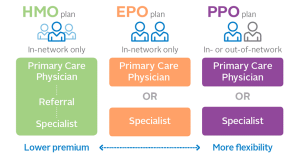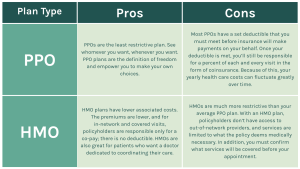Navigating the health insurance landscape can be challenging, especially when trying to understand the various types of plans available. Two of the most common types of health insurance plans are Health Maintenance Organizations (HMOs) and Preferred Provider Organizations (PPOs). Each has its own structure, benefits, and drawbacks. This article will explore the key differences between HMO and PPO plans to help you make an informed decision.
What is an HMO?
Definition and Structure
A Health Maintenance Organization (HMO) is a type of managed care health insurance plan that focuses on preventive care and efficient service delivery. Members are required to choose a primary care physician (PCP) who becomes their main point of contact for healthcare needs.

Key Features of HMO Plans
- Primary Care Physician (PCP):
Members must select a PCP who coordinates all healthcare services. To see a specialist, referrals from the PCP are generally required. - Network Limitations:
HMO plans typically have a restricted network of doctors and hospitals. Members must use providers within this network to receive coverage, except in emergencies. - Lower Costs:
HMO plans often have lower premiums and out-of-pocket costs compared to other plans, making them an attractive option for those seeking affordable coverage. - Emphasis on Preventive Care:
HMOs prioritize preventive services, such as annual check-ups and immunizations, often at no additional cost to members.
Pros and Cons of HMO Plans
Pros:
- Cost-Effective: Lower premiums and out-of-pocket expenses.
- Coordinated Care: Emphasis on preventive care and coordination through the PCP.
Cons:
- Limited Provider Choice: Less flexibility in choosing healthcare providers and specialists.
- Referral Requirements: Need for referrals to see specialists can delay care.
What is a PPO?
Definition and Structure
A Preferred Provider Organization (PPO) is another type of managed care plan that offers more flexibility in choosing healthcare providers. Members are not required to select a primary care physician and can see specialists without referrals.
Key Features of PPO Plans
- Flexibility in Provider Choice:
Members have the option to see any healthcare provider, but using in-network providers will result in lower costs. - No Referrals Required:
Unlike HMOs, PPO plans do not require referrals to see specialists, allowing for quicker access to specialized care. - Higher Premiums:
PPO plans generally have higher premiums and out-of-pocket costs compared to HMO plans. - Out-of-Network Coverage:
While PPOs offer coverage for out-of-network providers, members will pay more for these services.
Pros and Cons of PPO Plans
Pros:
- Greater Flexibility: Freedom to choose any provider without needing a referral.
- Access to Specialists: Easier access to specialized care without the need for a primary care physician.
Cons:
- Higher Costs: Typically higher premiums and out-of-pocket expenses.
- Complexity: The variety of provider options can make it challenging to navigate.
Comparing HMO and PPO Plans
| Feature | HMO | PPO |
|---|---|---|
| Primary Care Physician | Required | Not required |
| Referrals | Required for specialists | Not required |
| Network | Limited to in-network providers | Flexible, with in and out-of-network options |
| Cost | Generally lower premiums | Higher premiums and out-of-pocket costs |
| Preventive Care | Emphasized, often at no cost | Varies by plan |
Choosing Between HMO and PPO
When deciding between an HMO and a PPO, consider the following factors:
- Cost vs. Flexibility:
- If you prioritize lower costs and are comfortable with a limited network and referral requirements, an HMO may be the better option.
- If you value flexibility in choosing healthcare providers and are willing to pay higher premiums, a PPO may suit your needs better.
- Healthcare Needs:
- Consider your current health status and any ongoing treatments. If you frequently see specialists or prefer a wider choice of providers, a PPO might be more appropriate.
- If you generally require preventive care and have straightforward healthcare needs, an HMO can provide adequate coverage.
- Provider Relationships:
- If you already have established relationships with specific doctors or healthcare facilities, check whether they are in-network for the plan you are considering.
- Future Health Considerations:
- Think about potential future health needs. If you anticipate needing specialized care, a PPO may offer the flexibility you require.
Conclusion
Choosing between an HMO and a PPO involves weighing the benefits of cost savings and coordinated care against the advantages of flexibility and broader provider access. Understanding the key differences between these two types of health insurance plans will help you make an informed decision that aligns with your health care needs and financial situation.
Ultimately, the right choice will depend on your individual circumstances, preferences, and priorities. By carefully evaluating your options, you can select a health insurance plan that best supports your overall health and well-being.



